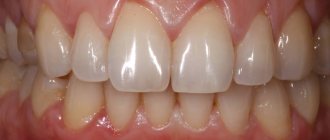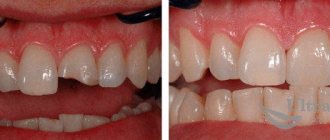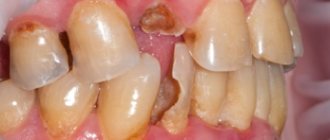Anyone can chip off a piece of their tooth, regardless of whether you take care of your teeth or not. Most often, this is preceded by a mechanical impact on the tooth, less often - gradual destruction of the integrity of the tooth, cracks in the enamel or the development of caries. The most common case is a blow, fall or other injury. Sometimes a tooth can chip when chewing, both in the front and back teeth. Moreover, you don’t have to chew nuts. Quite often, a tooth can break off when trying to bite off a piece of dry salted fish or meat.
It's clear. The way to avoid such a case is to be careful! In the article we will consider points that can increase the likelihood of an unpleasant incident.
Causes of chipped teeth
Several many:
- Weakening of dental tissue due to large consumption of sweets, juices, carbonated drinks and other foods that contain large amounts of sugar and acid;
- Malocclusion;
- Lack of calcium in the body;
- Reduced acidity in the oral cavity;
- Caries;
- Other diseases of the oral cavity;
- General weakening of the immune system;
- Hormonal disorders;
- Smoking;
- Diseases of internal organs.
These reasons, by the way, can also cause loosening of teeth and the development of all kinds of chronic diseases.
Example 1: Root caries
Caries, or a chipped tooth wall, extends deep under the gum.
Root caries is a direct indication for tooth extraction.
It is impossible to place a high-quality filling under the gum (there is always an overhanging edge, under which plaque and microbes accumulate). It will also not be possible to restore such a tooth with an artificial crown, because saliva and microbes will constantly get under the crown in the defect area; decementation of the crown and further destruction of root tissue will periodically occur.
That is, all attempts to “save” a tooth diagnosed with “root caries” can lead to the following:
accumulation of plaque and microbes under the installed filling or crown,
↓
the appearance of caries on the contact surface of an adjacent tooth,
↓
inflammation of the gum next to the tooth,
↓
formation of a deep periodontal pocket between the tooth and gum,
↓
gradual destruction of bone tissue around the tooth
↓
problems with implantation in this area.
Thus, treatment of teeth with tissue destruction below the gum level is pointless and can only be carried out as a temporary measure in order to delay the inevitable removal.
Types of chipped dental tissues
Depending on the depth of the damage, damage to the integrity of the tooth can be of several types:
- minimal,
- average,
- severe damage.
Let us now consider these options in more detail.
Minimal damage - a piece of tooth enamel chipped off
The tooth didn't break. Most often, emergency intervention from a specialist is not required. But you should pay attention to this point and consult a dentist. The fact is that if the chip is not healed in time, harmful bacteria can get into the crack and caries will begin to develop. In addition, you may not notice how the enamel will crack along the length of the entire tooth, right down to the root. Within six months, this lack of tooth integrity can lead to serious caries damage.
A piece of tooth has broken off, capturing the hard tissue of the tooth - dentin
It is located under the enamel. In this case, you also cannot feel pain or other unpleasant sensations. You should definitely visit a dental clinic! Even partial damage will cause tooth decay.
A large piece of the tooth broke off, exposing the nerve endings
Quite often in this case the tooth hurts. If not immediately, then it begins to hurt during the first days after the injury. We recommend that you consult a doctor as soon as possible to restore the integrity of the tooth. Otherwise, you can lose the tooth completely and “substitute” the neighboring teeth.
What is the reason?
The reason for the breakage (crumbling) of the tooth wall is simple - the tooth has been dead for a long time, the nerve has been removed, there was a large filling in the tooth, but it either crumbled or fell out. The tooth itself became fragile, and without a filling it could not withstand the stress and began to crumble, and pieces of the tooth suddenly chipped off. The remaining part of the tooth is in an even more deplorable state, the stress on it not only remains, but has increased, and the destruction of the entire tooth should be expected within a year.
Restoring a tooth by installing a filling will partially save it, but not for long. It is better to immediately address the issue of installing a crown using an inlay. A crown will reduce pressure and stress on a damaged tooth, thereby extending its “life.” The crown will stay on the tooth for an indefinite amount of time, it could be 10 years, or it could be one year; it is impossible to foresee and provide a guarantee in the case of a crumbling tooth.
Tooth restoration
No matter the scale of the tooth chipping, go to the dentist! There are no traditional methods or glue that can glue part of a tooth together. Only an experienced doctor can choose a treatment tactic.
The following options exist:
Small chips may not even need to be filled. Modern dentistry provides the most gentle way to restore tooth integrity.
For moderate damage, you will need to use a drill and install a filling, and sometimes build up a tooth.
In case of severe damage: installation of veneers, pins, crowns, inlays.
In particularly difficult cases, if the chip goes directly into the gum, the tooth may be removed.
What complications can there be?
Sometimes patients deliberately postpone visiting a doctor if the injury does not cause them the slightest discomfort. After all, a defect may not be too noticeable, but this does not mean that it can be ignored. Hard tissues will continue to deteriorate, and soon, in such conditions suitable for this, active pathogen activity will begin. Then caries, pulpitis, periodontitis - at this rate, after a while you can lose a tooth.
There are other consequences too. For example, sharp carved crowns can injure the inner surface of the cheeks, which can lead to infection through scratches and the development of chronic stomatitis. Therefore, the problem cannot be ignored, even if the damage is minor and does not in any way affect the appearance of the smile. The sooner you see a doctor, the easier and faster the doctor will be able to eliminate the defect.
Precautionary measures
Tips for avoiding chipped teeth follow general oral health tips:
- Visit your dentist regularly for dental examinations and professional teeth cleanings;
- taking vitamin and mineral complexes;
- brush your teeth morning and evening;
- limit the consumption of sweets, carbonated water, juices;
- do not smoke and limit alcohol consumption;
- treat teeth in the early stages of disease development;
- Treat diseases of organs and systems in a timely manner.
It is important to understand that an untreated tooth can lead to complications - from simple to very serious. Most often we are talking about caries, pulpitis, periodontitis. Doctors will confirm to you that a chipped tooth and infection can cause the development of chronic diseases of the heart, kidneys, stomach, liver, and nervous system.
INNOVASTOM offers an integrated approach to the treatment and prevention of dental and gum diseases in Smolensk. We are confident that we will help you maintain the health of your teeth!
Features of restoration of the roots of the frontal group of teeth destroyed below the gum level
The so-called all-ceramic designs of dentures (manufactured in various ways: slip casting, injection molding, layer-by-layer application of ceramic mass on a fire-resistant model, etc.) have become firmly established in practice, and today it is difficult to imagine a full range of work in orthopedic dentistry without them. The use of such structures has created new requirements for the tooth stump on which such a crown will be fixed (the minimum thickness of the crown should be 2.5 mm, requirements for transparency and polishing of the shoulder part of the stump). Some difficulties are presented by clinical cases when the tooth stump needs to be restored after a root fracture located just below the gum level. But even in such cases, adequate restoration of the destroyed tooth stump is possible. The main difficulty will be the requirements for surface drying when working with composite materials and dentin bonding agents used for core restoration, since drying the root surface located below the gum level is quite problematic. It is necessary to work with the obligatory use of a cofferdam and try to restore the initially destroyed wall at least to the level of the gum. You can then safely proceed with the adhesive fixation of the fiberglass pin in the root canal, since the transparency requirements complicate the use of metal pin structures for restoration. Using a clinical case, I would like to demonstrate a similar situation. A 22-year-old patient came to our clinic with a fracture of the crown of tooth 21 located below the gum level (Fig. 1).
rice. 1. Patient M., 22 years old, fracture of the crown of tooth 21 located below the level of the marginal gum.
At the same time, it was necessary to create the most “live”, natural work. We chose the treatment option using an all-ceramic crown. To do this, it was necessary to restore the destroyed tooth stump using materials close to the natural transparency of the tooth. For restoration, a composite material and a fiberglass pin were used, fixed in the canal using dual-curing cement (Fig. 3,4,5).
rice. 3. Using a cofferdam and contoured matrix strips, we restore the destroyed wall to the level of the gum.
rice. 4. We restore the cervical area of the stump while simultaneously preparing the canal for adhesive fixation of the pin.
rice. 5. The fiberglass pin is fixed.
Previously, endodontic treatment was carried out using the Thermafil system, as well as correction of the gingival margin on the medial side (Fig. 2).
rice. 2. Endodontic treatment of tooth 21 using the thermophil system.
The final preparation of the stump and especially its inferior part was carried out using carbide burs. We chose these burs due to a number of competitive advantages. Firstly, the sufficiently large length of the working surface of the bur allows processing the tooth stump to its entire height, which significantly facilitates the task performed (Fig. 6.).
rice. 6. A sufficiently large length of the working surface of the bur allows processing the tooth stump to its full height.
Secondly, carbide burs have horizontal notches located in a certain way on the working blades of the bur, which significantly speeds up the process of removing large volumes of hard tissue. Thirdly, the end of the bur head is increased in size and has a fairly large radius of curvature, with a complete absence of horizontal notches on the end of the bur head (Fig. 7.).
rice. 7. The end of the bur head is increased in size and has a fairly large radius of curvature, with a complete absence of horizontal notches on the end of the bur head.
This design of the bur makes it simply an ideal tool for forming the final ledge on the tooth stump and, at the same time, for finishing the ledge to a glossy surface. (Fig. 8.9.)
rice. 8. The formed ledge on the tooth stump is clearly visible.
Fig. 9. The ledge on the stump of the prepared tooth is polished to a glossy surface.
Using carbide burs, we can easily create a rational, semicircular ledge for a future all-ceramic crown. Subsequently, we only correct it with a bur that has a larger radius of curvature of the head, which allows us to level the surface of the ledge, removing sharp edges and elevations at the border of the ledge and the gums. It should be noted that the production of such work requires very careful preparation with a good centered tool. Since only a perfectly formed stump, without undercuts, will enable the technician to create a crown that fits exactly to the stump. Otherwise, there is a danger of the ceramic structure splitting due to microstresses arising in the ceramic during function, due to uneven contact with the stump. We carried out the taking of a double refined impression and the direct production of a provisional crown according to the generally accepted method. We carried out the final fixation of the finished artificial crown using dual-curing composite cement, since only this group of materials is capable of forming a chemical bond with both the tooth stump and the crown. In addition, these materials are quite strong, plastic and fluid, and also have a fairly wide range of colors and gradations of transparency, which ensures natural color rendition and transparency of the artificial crown (Fig. 10).
Fig. 10. Finished work in the oral cavity.
Example 3. Chronic periodontitis, significant root exposure, tooth mobility
If chronic periodontitis (periodontal disease) is accompanied by significant loss of bone tissue (more than ½ of the root length), tooth mobility, and exposure of root bifurcations, tooth extraction is the only possible solution to the problem.
In the case of periodontal disease, the main problem is the presence of periodontal pockets and loss (atrophy) of the bone tissue around the teeth. The roots are gradually exposed, and tooth mobility appears. If the periodontal pockets are so deep that even periodontal surgery cannot solve the situation, it is necessary to remove such teeth, because Millions of microbes accumulate in the pockets, which further “corrode” the bone. It is better not to wait until the teeth fall out on their own, but to remove the source of infection, thereby preventing further loss of bone tissue and leaving the possibility of implantation.
Chip in the front row of teeth
Typically, such chips occur when biting or a strong blow. Even the smallest defects are noticeable on the front row, so a small chip can cause not only discomfort, but also psychological problems. Also, the aesthetics are spoiled by microcracks, which over time begin to turn black and become more and more visible.
When small cracks appear, fluoridation and mineralization are usually sufficient. If the enamel has been severely damaged and part of the tooth has broken off, installing an artificial veneer would be a good solution. In our clinic, your dentist will install veneers or ultraneers for you. If the damage is severe, the only option is removal, prosthetics or implantation.
Example 2. Chronic periodontitis
Chronic periodontitis with the presence of a large cyst or granuloma, as well as with difficult-to-pass root canals filled with dense cement-like material.
Chronic periodontitis is an inflammation of the tissues surrounding the root of the tooth. Microbes in the bone tissue that enter through the root canals lead to the destruction of the bone around the root, creating a cavity filled with bacteria, granulation tissue and, sometimes, pus (i.e., a cyst or granuloma is formed).
If the size of the cyst (or granuloma) is small, and it is located at the very tip of the root, you can try to “save” the tooth using a conservative method (unseal the root canals, clean them, apply an antiseptic for a while, then hermetically seal the canals and restore the crown part of the tooth ).
If the size of the cyst is significant or it is located along the lateral surface of the tooth root (or between the roots), and also if it is not possible to unfill the root canals and it is impossible to perform a tooth-preserving operation, then the best option is tooth extraction.
After all, periodontitis, like any chronic source of inflammation, causes harm to the entire body (microbes, getting from the site into the blood, can multiply in other organs and cause autoimmune processes).
In addition, the cost of labor-intensive therapeutic treatment of periodontitis is usually comparable to tooth extraction and subsequent implantation.











